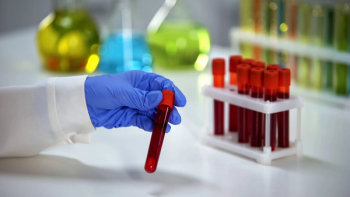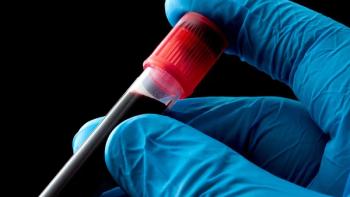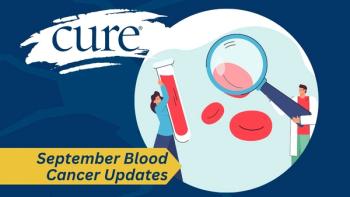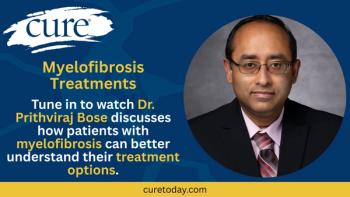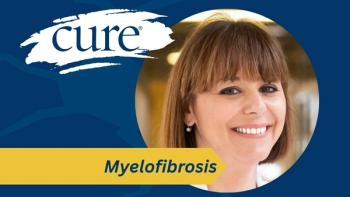
- Summer 2019
- Volume 1
- Issue 1
The Gift of Cancer Registries
Collecting data about cancer through registries can help experts detect trends and patterns, leading to better care for patients.
After Rhonda Meckstroth’s husband, Jeff Meckstroth, received a diagnosis of stage 4 non-small cell lung cancer (NSCLC) with an ALK rearrangement, a particular kind of gene abnormality, the two made a deal with each other: She would focus on tracking research and ensuring that he received state-of-the-art treatment, and he would focus on doing what he loves — tending to his 700-acre family farm in Ohio and living his life as fully as possible.
Four years later, the couple’s agreement has proved successful. Despite multiple metastases in his bones, lymph nodes and brain, and after participating in a clinical trial and cycling through two types of targeted therapies, Jeff Meckstroth is doing well on a third one, Lorbrena (lorlatinib) — and Rhonda Meckstroth’s supportive efforts now focus not only on her husband but also on the larger lung cancer community.
In addition to serving as an administrator of ALK Positive (alkpositive.org), an online international support group, Rhonda Meckstroth supports the Lung Cancer Registry by raising awareness and recruiting patients. The registry allows patients to contribute their health data so that researchers can better study and understand the disease and develop better treatments. It also helps inform patients about clinical trials for which they might be eligible. The goal is to provide a secure, confidential portal of mass data helping scientists, doctors and others develop new avenues to prevention, treatments and a cure.
Sponsored by the American Lung Association, the GO2 Foundation for Lung Cancer and the International Association for the Study of Lung Cancer, the registry is one of thousands in the cancer community that serve different functions aimed at research and patient support. The registries vary in size; some get their data directly from patients, and others track it through hospital or public health records. Rhonda Meckstroth sees registries as a two-way communication tool: Patients can find out about the latest advances in research and clinical trials, and the medical community can learn about patient perspectives on treatment, side effects and quality of life.
“Data collection through registries is critical for accelerating advances in research and for improving therapies,” she says. “They also give patients and caregivers a sense of control and a voice, providing a way to actively participate in research and development. If we’re going to find a cure for cancer, understanding every aspect of disease management — from screening guidelines to testing requirements to managing side effects — is required. Without patient input, it’s very difficult to connect all those dots.”
A Comprehensive Network of Registries
Patient registries are the newest in a family of cancer registries that has been collecting data for decades. The first national cancer registry, the Surveillance, Epidemiology, and End Results Program, or SEER, began in 1973, two years after President Richard Nixon declared a war on cancer. It is administered by the National Cancer Institute (NCI), part of the National Institutes of Health (NIH). In the 1970s, the registry collected data from just a few states, but it now covers about 35% of the U.S. population.
In 1992, legislation was passed requiring every state to have its own registry. To meet this need, the Centers for Disease Control and Prevention (CDC) established the National Program of Cancer Registries (NPCR) to support or expand registries in all states. Today, NPCR includes 46 states, the District of Columbia and three territories. Working together, SEER and NPCR collect and consolidate information on every reportable cancer case in every state and from multiple settings, including hospitals, outpatient facilities and pathology labs. Information on more than 1.7 million new cancer cases is reported to the two organizations each year; together, they gather data on 100% of America’s treated cancer cases. The combined data is released annually as U.S. Cancer Statistics, painting a comprehensive picture of patients with cancer, the treatments they receive and where different subtypes of the disease tend to be the most prevalent.
“Over the years, we have improved our data collection efforts by increasing the number of states reporting and improving the quality and completeness of the data and its timeliness,” explains Dr. Loria Pollack, senior medical officer for NPCR. “Our goal at the CDC is to not only collect data but also to use that information to implement cancer control programs.”
The growth of electronic medical records and pathology reports has pushed NPCR to build its capacity so that key pieces of information can be sent directly to the registry. NPCR is working with its partners, including the College of American Pathologists and the American College of Surgeons, to standardize and streamline reporting so the different registries can work together seamlessly.
To complement those efforts, the National Cancer Database (NCDB) collects data from 1,500 cancer treat- ment programs accredited by the Commission on Cancer, which is part of the American College of Surgeons and manages the registry with the American Cancer Society. Started in 1989, this registry includes 70% of all newly diagnosed cancer cases and contributes data to NPCR and SEER.
These registries and others may have limitations: For instance, NCDB mainly records initial therapies for early-stage disease, not capturing many details about long-term follow-up, recurrences or associated treatments. Some registries may also be limited regarding which outcomes, such as survival or disease-free survival, they measure.
Both NPCR and NCDB collect data on patient characteristics, gender, age, type of tumor, diagnosis, stage and some biomarkers. What distinguishes these two registries is that the former looks at health trends based on information about individual patients in each state, whereas the latter considers information related to institutional issues, such as concerns about provision of care. As a result, the information tends to be used for different kinds of research studies.
For example, researchers using NPCR data usually look for patterns and trends at the state level to target needed action. “Based on recent cancer statistics from Texas, researchers were able to raise awareness about how being overweight or obese is a risk factor for certain kinds of cancer,” Pollack says. “After public health officials in Mississippi discovered that the state had high rates of women with breast cancer and death from the disease, especially in the poorest areas, they organized a screening event at the University of Mississippi homecoming game. With an eye to cancer prevention and control, states are always looking for opportunities to use the data in positive ways.”
The NCDB registry looks more closely at patterns of care and what factors cause differences, such as socioeconomic status and race. Leticia Nogueira, a principal scientist with the Surveillance and Health Services Research Program at the American Cancer Society, is the program’s point person for the registry. She notes that several studies based on NCDB data have found a connection between the lack of health insurance and poor quality of care.
“One study published in the Journal of Clinical Oncology (JCO) in 2015 found that increased travel time for treatment among patients with stage 3 colon cancer meant that they were less likely to receive chemotherapy, as were patients with public insurance living in areas with a relatively small number of oncologists,” Nogueira says. “A later JCO study (2017) found a connection between lack of insurance and risk of death among black women with breast cancer. Both studies made good use of NCDB data to demonstrate the important role of health insurance coverage in maintaining an optimal level of cancer care and preventing disparities.”
The NCDB also serves as a quality-control tool for the facilities themselves. They can not only see how they’re doing in terms of quality measures but also assess their progress compared with that of other hospitals.
Growing Patient Involvement
Large registries can have an impact at the national, state, institutional and practice levels. But these data collections lack one crucial element: the patients’ point of view. Patient registries fill this gap, providing a privacy- protected space so that each patient can document his or her own unique experience. “Patient registries are capturing the patient voice and empowering them to become involved in research,” says Sandra S. Shaw, director of the Lung Cancer Registry. “The hope is that the data donated by patients will power breakthroughs and drive outcomes.”
Donna Fernandez, of Dallas, has been living with lung cancer since 2012. She attributes her long-term survival to her robust response to the immunotherapy Opdivo (nivolumab). As a longtime activist and a contributor to the Lung Cancer Registry, Fernandez says that she “can’t help but help.”
“There is so much misinformation out there about the disease; many doctors believe that smoking is the only cause and that only people over 70 get this disease, neither of which is true,” Fernandez says. “The registry is a way to distribute accurate information.”
With so many patients with lung cancer living longer, it is now possible to track their progress over time, Shaw adds. Down the road, she plans to ask patients to contribute data every quarter so that researchers can evaluate issues such as how treatments are changing over time, which patients are at higher risk of complications like blood clots and the trajectories of patients with different genomic biomarkers.
Although hospitals report their data to the NCDB, many also manage smaller patient-reported registries. At Dana-Farber Cancer Institute in Boston, the breast oncology division operates at least four registries that include a range of patients, including young women with breast cancer, those with the triple-negative and inflammatory subtypes, and women with metastatic disease.
Dr. Eric P. Winer, chief of breast oncology, chief clinical strategy officer and senior vice president of medical affairs at Dana-Farber, who oversees the registries, views them as filling a unique niche in the research community by developing groups of patients that can be followed over time. “Not only can we track their progress, but we can also pose numerous questions related to the biology of the cancer, the impact of treatment and the outcomes of patients’ experience,” Winer says. Sometimes those outcomes are unexpected, leading to the need for a more specialized registry to address a specific problem.
When women with breast implants began experiencing health problems, the American Society of Plastic Surgeons formed the National Breast Implant Registry. Dr. Andrea Pusic, chief of plastic and reconstructive surgery at Brigham and Women’s Hospital in Boston and president of the Plastic Surgery Foundation, manages the registry.
“We’ve been performing cancer reconstruction surgery for a long time, and (we) have been doing everything we can to monitor safety,” Pusic says. “But the registry will be a way to use confidential, protected information to track how women are doing and compare one implant to another.”
In collaboration with the Food and Drug Administration (FDA) and breast implant manufacturers, the registry was launched in October 2018; for now, the data comes from surgeons. In the next phase, patients will be able to report on any negative symptoms they experience.
The Pros and Cons of Patient Registries
Although patient registries are gaining in popularity, there’s some skepticism in the oncology community. Nogueira points out that the patients are self-selecting and share characteristics — such as higher education levels and access to computers — that might not represent the general population. “I would be concerned about generalizing this data to the population as a whole,” she adds. “Researchers will need to be very careful about the questions they select.”
Michelle Woehrle, executive director of the Myeloproliferative Neoplasm (MPN) Research Foundation, which has a registry called myMPN, recognizes another problem with patient-reported data: The medical community doesn’t always respect it. To address this issue, Woehrle is working to validate the data the registry collects by augmenting it with patient-supplied medical records.
Lindsey Whyte, the registry project manager, adds that the FDA recently lent credence to patient-reported data by issuing draft guidance stating that real-world evidence can now be used to support drug development.
When it comes to rare cancers like MPNs, the FDA also suggests that registries can contribute to better care for patients. It recommends that investigators turn to registries, especially those focused on rare diseases, to find patients for clinical trials. Likewise, registries can provide researchers and physicians with insight into diseases for which there is limited information, according to Woehrle and Whyte.
Those interested in participating in registries can refer to a list put together by the NIH (nih.gov/health-information/nih-clinical-research-trials-you/list-registries) or check with patient advocacy groups that focus on their cancer types.
Participants often find that the benefits feel personal. Nancy*, from Arizona, has myelofibrosis, one of the rare blood diseases under the MPN umbrella.
Now 61, she has had the disease for 38 years, making her one of the longest living individuals with this condition.
“This is such a rare disease, so I often feel quite alone,” Nancy says. “The registry relieves some of that loneliness and makes me feel that, as a patient, I’m providing information that would not otherwise be accessed by medical researchers and will eventually result in new treatments and a cure. My hope is that it will happen in my lifetime.”
*Last name omitted for anonymity by request.
Articles in this issue
about 6 years ago
Taking on Pancreatic Cancerabout 6 years ago
Agents of Choiceabout 6 years ago
Surprised by Side Effectsabout 6 years ago
Our Sisters' Keepersabout 6 years ago
Making Headway Against a Common and Disruptive Problem: Lymphedemaabout 6 years ago
To Improve Quality of Life and Health Outcomes, Seek Supportive Careabout 6 years ago
A Look Inside a Supportive Care Clinicabout 6 years ago
Reducing the Risk for Esophageal Cancerabout 6 years ago
Thinking Outside the Box With Esophageal Cancer Treatmentabout 6 years ago
Dream Sequence
